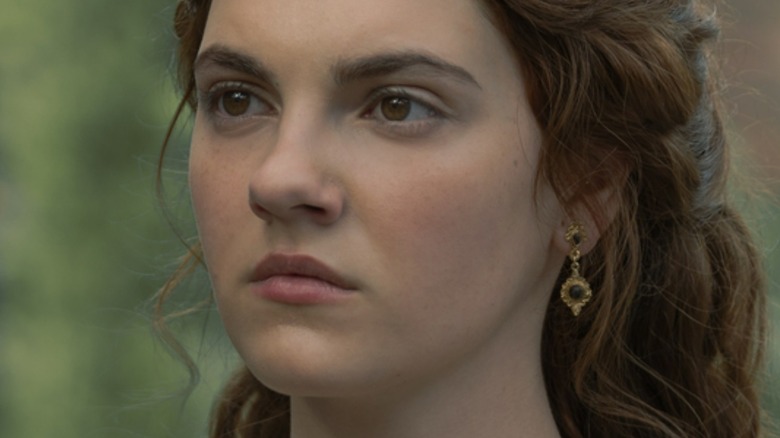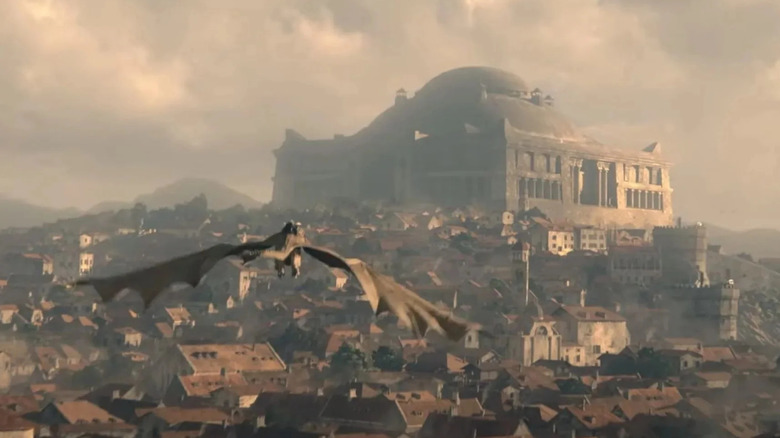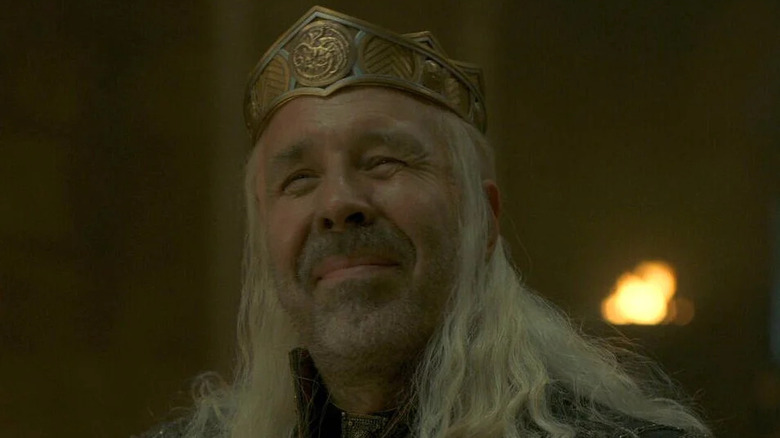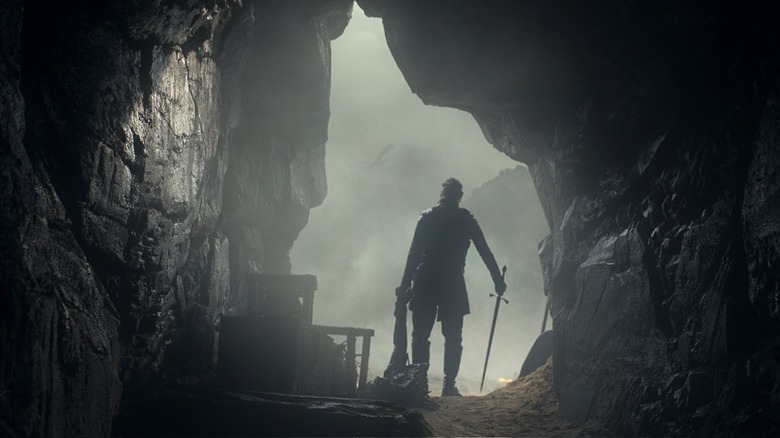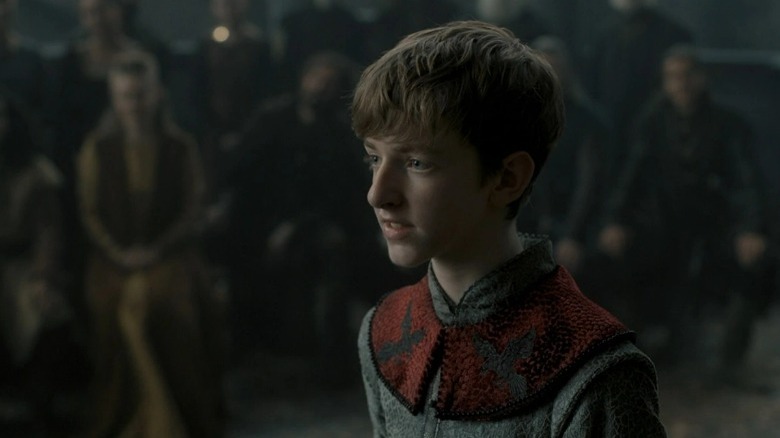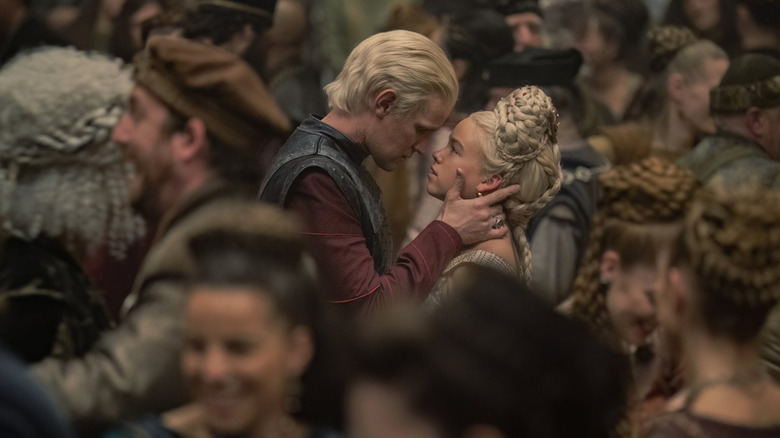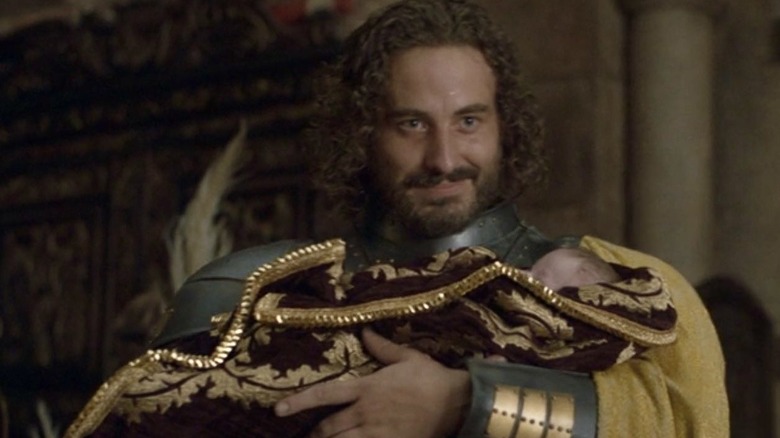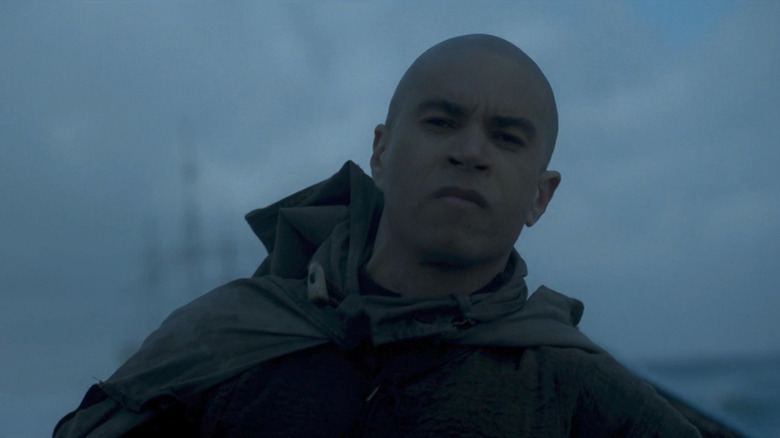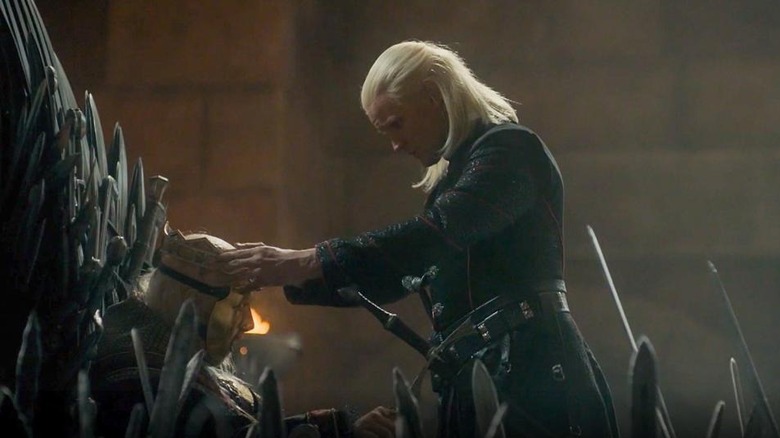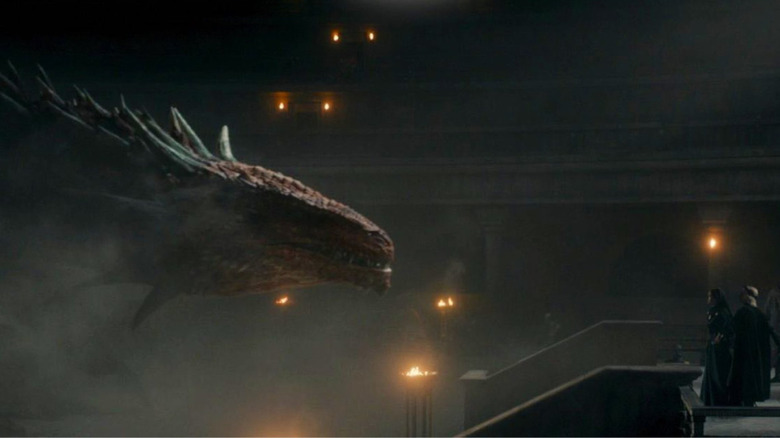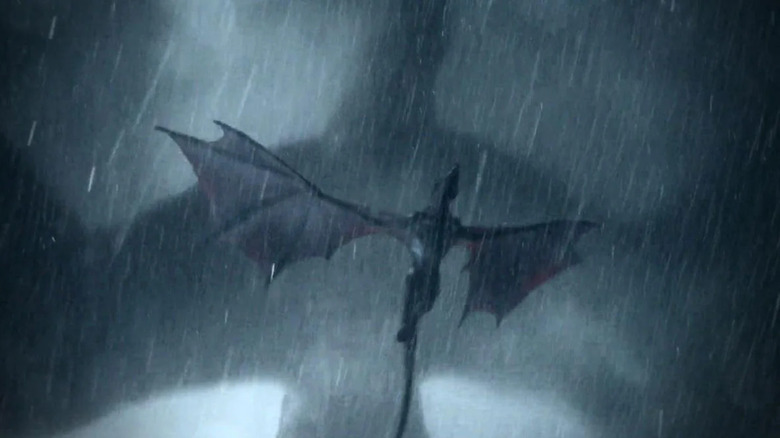The Most Pause-Worthy Moments From House Of The Dragon Season 1
"House of the Dragon" covered a lot of ground in its first season. The "Game of Thrones" prequel series takes place over about thirty years, during which time the characters experience more births, marriages, and deaths than they can count on two hands — not to mention an ongoing war. Then there's the small matter of gigantic dragons, which were commonplace through the reigns of King Jaehaerys and Viserys Targaryen.
That means "House of the Dragon" is bursting at its green and black seams with spectacle. However, the series also uses visual storytelling techniques to communicate key plot and character information. This is important since there isn't much dialogue in the source material, George R. R. Martin's "Fire & Blood," which means viewers not only have to listen for clues and callbacks, they have to watch for them.
There were no shortage of frames that warranted the pressing of the pause button in Season 1. From the premiere episode's bloody tournament to Vaemond's tongue-in-cheek beheading to the moment Queen Rhaenyra inherited her father's crown, the show delivered on (and in some cases, improved upon) the best and most important parts of the book. Some made us wince, some made us smile, and some made us cry, just as Martin and the showrunners intended. These are the moments that made the biggest impact.
Syrax flies to the Dragonpit
The premiere episode of "House of the Dragon" begins with a prologue that takes place around ten years before the real action starts. That scene is narrated by Rhaenyra, who informs us that the great council chose her father over Princess Rhaenys on account of his being male. However, she also tells us that at this time the Targaryens were at the height of their power and in possession of 10 adult dragons. Once we cut to the show proper, the first thing we see is one of those dragons in flight. Syrax, with a teenage Princess Rhaenyra in her saddle, gives us an aerial tour of King's Landing. She navigates around the spires of the Red Keep and soars over the streets before making her way to her destination — the enormous Dragonpit.
The prequel series is smaller in scope than its predecessor, "Game of Thrones," in that it focuses primarily on one family. However, it easily bests the original in terms of the franchise's primary spectacle: dragons. It was a stroke of genius for showrunners to kick off "House of the Dragon" with these breathtaking images. The opening sequence leans into the fact that this story is significantly more dragon-centric than "Game of Thrones" ever was while injecting a dose of familiarity for returning viewers. After Daenerys and Drogon laid waste to King's Landing in the finale season, it's a joy to see the city in its heyday, and it's especially exciting to see the Dragonpit in its original glory.
The Targaryen smirk
Fans love the "Game of Thrones" extended universe for its dramatic palace intrigue and even more dramatic graphic violence, and Season 1 of "House of the Dragon" gave them plenty of stills of glowering faces and gory bodily harm. Still, one quiet moment of levity cut through the extremity to trend on Twitter.
The show's King Viserys is quite a bit different than the book's version. On paper, he's a lazy, gluttonous party king who loves nothing more than feasts and tourneys. He dies not of a leprosy-like wasting disease but of gout and other complications from his indulgence. In "House of the Dragon," Viserys (as Martin himself pointed out) is more of a tragic King Lear figure, worrying over his model Valyria and every decision he has to make. On the whole, it's an improvement, but Paddy Considine's King Viserys isn't a total downer. On at least two occasions beginning in Episode 2, he smirks or squints as he smiles in a way that's charmingly condescending.
Audiences couldn't help but notice the resemblance to Daenerys Targaryen's infamous squint. "Turns out it runs in the family," became a common refrain as internet users updated the meme with side-by-side portraits.
Daemon slays the Crabfeeder
From Blackwater to the Battle of the Bastards, "Game of Thrones" featured some of the most heart-pounding battles ever recorded for television. "House of the Dragon" will have its chance to do the same in Season 2 and beyond once the Targaryen civil war begins, but for now viewers have to be content with the War for the Stepstones in Season 1, which begins and ends in Episode 3. In between, there's symbolic violence at a hunt to celebrate Viserys and Alicent's son Aegon's second name day. King Viserys struggles to put a tied-down stag out of its misery while Rhaenyra goes hog wild stabbing a boar to death. A moment of restraint comes when Rhaenyra chooses not to slay the white stag, which almost makes for one of the most arresting sights in a visually interesting episode.
But back to the Stepstones. The opening battle, in which Caraxes appears only to stomp one of the Crabfeeder's victims, is an effective mood-setter, and it's always compelling to see a fire-breathing dragon as an instrument of war. Still, the award for the best single shot goes to a fleeting image of Daemon framed from behind in the mouth of a wet cave. In one hand, he holds his ancestral Valyrian steel sword, Dark Sister. In the other, he holds a dead body by the wrist. Outside, Seasmoke flies through the mist.
A gruesome next shot reveals Daemon has sliced straight through the Crabfeeder's torso. It was an interesting choice not to show Daemon committing the act — and one that keeps with the morally gray and not always reliable legend the character is building for himself.
Samwell Blackwood's no craven
What the "Game of Thrones" franchise has on its main competitor in the period fantasy genre is a great deal more sex and violence. The vast majority of Episode 4 of "House of the Dragon" is about sex. Rhaenyra almost has it with Daemon, does have it with Ser Criston Cole, and is surrounded by it on the Street of Silk. Alicent has to have it with Viserys. It's all anybody can talk about at the end of the hour when Otto brings word of some unsanctioned royal "coupling." Before Criston became one of the show's most hated villains, people may have paused on what seemed like a genuine love scene between the princess and her sworn protector. However, show creatives made it a point to avoid exploiting women in the prequel (something for which "Game of Thrones" was often criticized), so all that tension is a vibe more than it is explicit.
That leaves violence, one of the most unexpected incidents of which occurs on Rhaenyra's engagement tour. She visits Storm's End, where a queue of eligible bachelors vie for her hand, as Viserys has allowed her to choose a husband. She's entertained by an adorable, precocious 12-year-old Blackwood boy, who promises her easy days and safe nights. A young Bracken man mocks him and calls him craven. Rhaenyra's had enough of this nonsense, and so has the tween-age Samwell Blackwood who spills the guts of the Bracken man with his longsword.
"Don't look, Princess," Criston says. However, audiences were interested in seeing this duel between the constantly at-odds Blackwood and Bracken families, which is mentioned in "Fire & Blood."
Did Daemon and Rhaenyra kiss at her wedding feast?
Daemon and Rhaenyra have a not-so-slow burn romance going on from the second he clasps that Valyrian steel pendant around her neck in Episode 1. It was a daunting task to convince viewers not only to allow for incest but to hold out hope for a relationship that began between a man of 30 and a girl of 14. While Matt Smith's performance in Episode 2, "The Rogue Prince," has drawn deserved praise, the love between this pair only comes off as not creepy because Rhaenyra is a commanding presence who frequently calls Daemon's bluff. She does so in Episode 2, correctly guessing that he won't kill her to take Dragonstone and her place in the succession. She does it again when the exiled Prince returns (fresh from murdering his wife) to cause chaos at her wedding feast to Laenor Velaryon.
After she and her closeted bestie-slash-fiancé light up the dance floor, Laenor goes looking for his real date, Ser Joffrey, while Daemon cuts in on Ser Harwin Strong and the bride-to-be. Daemon tells Rhaenyra that Laenor will bore her senseless. "So take me then," she says, daring him. "Cut through my father's Kingsguard. Take me to Dragonstone and make me your wife." Daemon grabs her and appears to lean in for a kiss — the sight of which an angry King Viserys catches — but then the crowd gets in his and the audience's way.
We'll never know what happened between that moment up until the deadly brawl that Criston and Joffrey eventually have, but by Episode 7 Daemon and Rhaenyra are in Dragonstone exchanging vows of their own.
Harwin Strong, proud dad
In Episode 6, we're re-introduced to the characters after a ten-year time jump, beginning with adult Rhaenyra giving birth to not her first but her third child. In short order, we come to learn that these are the Princess' children with Ser Harwin Strong, Commander of the City Watch and son of the Hand of the King — not Laenor Velaryon. Our first clue is the horrid way an outraged Queen Alicent treats Rhaenyra and Laenor immediately after the delivery of baby Joffrey. That Harwin is the father is confirmed when Rhaenyra asks Laenor to let Strong hold the baby.
The burly and securely-masculine Harwin grins from ear to ear as he cradles his newborn boy. Fans of the swoon-worthy character had to savor this lone facial expression for all it was worth, as it was basically all they got of what might have been the healthiest relationship in Westeros — though a close second is the look that Harwin gives Rhaenyra when she returns from Episode 3's hunt covered in boar blood.
Their wholesome stolen moment was a breath of fresh air in an hour that contained placenta sound effects and an afterbirth trail, the cutting out of tongues, and multiple grisly deaths by fire (including Harwin's). It's also tragic, as it portends what might have been. The secret to happiness might be thus: get yourself someone who looks at you the way Harwin Strong looks at his baby mama.
Laenor rows away
Daemon Targaryen does a lot of awful things in Season 1 of "House of the Dragon," so when he and Rhaenyra discuss marriage, nobody puts it past him to take out Laenor Velaryon, who stands in his way. Book readers especially thought they knew where Episode 7 was going. In "Fire & Blood," Qarl — Laenor's companion — kills him in front of witnesses at a market. Though the official story is that Qarl was jealous that Laenor had taken a younger lover, the subtext implies Daemon hired Qarl to kill Laenor once Laena died in childbirth. Beyond that, some readers theorize that since Qarl was never seen again, Daemon slayed his paid assassin to cover up his crime.
We see evidence for that outcome as Daemon and Rhaenyra openly acknowledge that Laenor will have to go. A montage shows Daemon in his murder cloak propositioning Qarl, after which Qarl starts his public beef with his boyfriend. However, there are two hints that something is amiss. Daemon kills a random servant on the stairs — a pause-worthy shot in and of itself — and Rhaenyra says that while fire is a prison, the sea is an escape.
The episode concludes with a major twist. Laenor (with a shaved head) and Qarl are rowing away to Essos together, presumably with Daemon's money and blessing. Though it's confusing upon the first watch, Daemon twisted the neck of the servant to plant the body in the fireplace, which allows for Laenor's escape. This marked the most drastic detour from the book and perhaps the biggest surprise of the season.
Daemon crowns Viserys
The most tear-jerking moment of Season 1 of "House of the Dragon" was an improvisation by Matt Smith. A stellar Episode 8 is the swan song of King Viserys, who dies after years and years of suffering in the final shot. Before he shoves off this mortal coil, he makes a last stand in support of his daughter, Rhaenyra, and her sons. King Viserys, who can barely breathe or sit upright, decides to abstain from his milk of the poppy tea for one night to retain his faculties for what he (correctly) expects to be a final family dinner. He surprises everyone (most of all, Otto Hightower, who's in his chair) when he shows up to rule over Vaemond's challenge to Lucerys' claim on Driftmark. King Viserys' arduous and very long walk to the Iron Throne is perhaps the most cinematic scene of these first 10 episodes. When he gets to the dais, pitifully hunched over, his crown falls from his head.
Daemon — who everyone (again, especially Otto) thought wanted the crown for himself — bends over to retrieve it, then respectfully places it back atop the pate of the King, symbolically restoring his dignity and power after the Greens have systematically taken them from him. This small bit of business is beautifully acted by both Smith and Considine, and it's just as beautifully captured by the team of directors and cinematographers who made the most of this happy accident. The Rogue Prince crowning the Peaceful King provides perfect closure to Viserys and Daemon's complicated but ultimately deep and abiding sense of brotherhood.
The Red Queen interrupts these proceedings
Episode 9, in which the Greens usurp the Iron Throne from the Blacks, is like one long I-can't-believe-this-is-happening shock to the system — except for viewers who'd read "Fire & Blood." Still, even book readers were shocked at the epic conclusion. This chapter felt like it was over when Aegon — who seconds earlier had no interest in ruling — thrust his great-great-grandfather's sword into the air, suddenly seeming to relish the adoration he received from and the control he wielded over the masses. Then, Meleys the Red Queen crashes his coronation to show the usurper and his side of the family that they have a long way to go if they wish to reign supreme.
This plot point is a show invention that makes Princess Rhaenys look unbelievably cool in her Valyrian steel and copper armor as she puts Aegon — who, at the mercy of the dragon, looks like a petulant child playing dress up — in his place. When Meleys roars and Alicent steps in front of her son, it gives viewers one of their closest and most sustained glimpses of a dragon this season.
Fans tracking Helaena's prophetic ramblings also paused to see if Meleys had triumphantly broken through the floor. She did (probably killing hundreds of small folk in the process), perhaps fulfilling the new Queen's warning that a beast lurked beneath the boards. However, Meleys's surprise appearance didn't cost Helaena or her family anything. Her cryptic message may have referred to this catastrophe, a looming one that's waiting in Season 2, or both.
Vhagar flies over Arrax
Season 1 of "House of the Dragon" time jumped through nine episodes to get to this, the Fight above Shipbreaker Bay. Luke and Arrax fly to Storm's End on behalf of his mother expecting a warm welcome from the Baratheons. Instead, a petrified Luke sees Vhagar towering over the castle wall and finds Aemond waiting for him, having already secured the support of Lord Borros through a marriage pact. Borros doesn't want bloodshed under his roof, but he doesn't care what trouble the boys get up to in the neutral skies and waters. Luke swore to his mother he wouldn't fight and tries to flee on Arrax, but Aemond and Vhagar are close behind.
Just as they must in the book, the boy and his dragon fly through sheets of rain and heavy fog. They (and we) think they might've gotten away before the shadowy outline of Vhagar clouds what little light there is from above. In "Fire & Blood," Vhagar is said to be five times larger than Arrax, but this dragon is like a warplane hovering ominously over a kite. Luke and Arrax soon reach clear skies and believe themselves free of Aemond and Vhagar's threat again — only to be eaten alive.
That shot is eyeball-popping crazy, especially for viewers who didn't know it was coming. But the contrast between the 180-year-old veteran dragon and the innocent creature who was hatched only 14 years ago is the thing that builds the necessary tension to make the eventual attack pay off.
